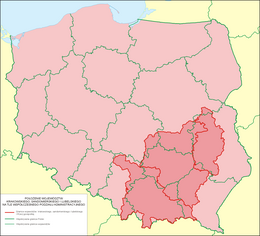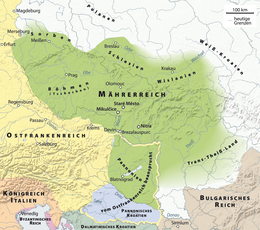Lesser Poland


Lesser Poland (since the Middle Ages Latin Polonia Minor , Polish Małopolska ) is originally the name for the southern part of the old Polish state with the metropolises Krakow , Lublin , Zamość and Sandomierz .
During their affiliation to Poland-Lithuania from 1569 ( Union of Lublin ) the Ukrainian regions Galicia , Podolia , Volhynia , Kiev etc. a. also in the term. The Greater Province of Lesser Poland existed until 1772 .
Name and meaning
The name Polonia minor was first mentioned in 1493 in the "Statutes of Piotrków". It has nothing to do with the territorial size of the area, but with the accession to the already existing Polonia maior in the year 990. Therefore, the translations New Poland and Old Poland would be more appropriate than Lesser Poland and Greater Poland .
location
According to the latest administrative division of Poland, Lesser Poland extends to today's voivodeships of Lesser Poland , Świętokrzyskie and the western parts of the Lublin and Subcarpathian Voivodeships as well as smaller parts of the Silesian Voivodeships (north and east), Łódź (east) and Mazovia (south).
nature
The Vistula is characteristic with its numerous tributaries. The region also has a share of the Tatra Mountains with the winter sports area around the city of Zakopane .
Cities
- Population as of June 30, 2016
| Surname | Pop. | Voivodeship | |
|---|---|---|---|
| Krakow | 762,448 | Lesser Poland | |
| Lublin | 340.745 | Lublin | |
| Czestochowa | 227.270 | Silesia | |
| Radome | 215,653 | Mazovia | |
| Sosnowitz | 206,516 | Silesia | |
| Kielce | 197.724 | Holy Cross | |
| Bielsko-Biała | 172.407 | Silesia | |
| Dąbrowa Górnicza | 122,451 | Silesia | |
| Tarnów | 110.381 | Lesser Poland | |
| Jaworzno | 92,618 | Silesia | |
| Nowy Sącz | 83,829 | Lesser Poland | |
| Siedlce | 77,072 | Mazovia | |
| Ostrowiec Świętokrzyski | 70,396 | Holy Cross | |
| Tomaszów Mazowiecki | 63,601 | Łódź | |
| Stalowa Wola | 62,636 | Subcarpathian | |
| Mielec | 60,628 | Subcarpathian | |
| Będzin | 57,761 | Silesia | |
| Zawiercie | 50.504 | Silesia | |
| Starachowice | 50.174 | Holy Cross | |
| Puławy | 48,526 | Lublin | |
| Tarnobrzeg | 47,658 | Subcarpathian | |
| Skarżysko-Kamienna | 46,656 | Holy Cross | |
| Dębica | 46.276 | Subcarpathian |
Regions
Regions in Lesser Poland are:
- Podhale ( Subcarpathian ) with Nowy Targ and Zakopane
- Powiśle Lubelskie with Opole Lubelskie
- Sądecczyzna
- Zagłębie Dąbrowskie
- Zagłębie Krakowskie
- Żywiecczyzna
history

850-990
Since the 9th century, a settlement area has been mentioned for the area of what will later become Malopolska. At least since 884 this area belonged to the Great Moravian Empire . In the description of the work of the Slav apostle Method , a " very strong pagan prince on the Vistula was named. This was to be converted to Christianity. His rulership was probably Krakow.
Around 890 a "Wisle lond" ( Weichselland ) was mentioned in the journey of the Anglo-Saxon Wulfstan of Haithabu .
The Bavarian Geographer mentioned early 10th century in his second part of a region of Vvislani ( Vistulans ) without increasing the number of castles.
953 in the book of Josippon in a list of different peoples of the time, Kr [a] k [a] r , probably Cracow, are also mentioned.
In 965/973 the Islamic-Jewish traveler Ibrahim ibn Jaqub named the place K [a] rākō / K [a] rākū . This was under the rule of the Duchy of Bohemia . In a border description of the diocese of Prague , a region around Krakovv Castle was mentioned for about 973 . This belonged to the diocese of Prague, and thus probably still to Bohemia.
Cracow was mentioned in the so-called Dagome iudex around 990 . At that time it did not belong to the Schinesghe ( Gnesen ) domain .
990-1772
Around 990 the area around Kraków was conquered by Mieszko I. In the year 1000 the diocese of Krakow was incorporated into the new archdiocese of Gniezno .
In 1038 after the destruction of the main town Gniezno by the Bohemians , Krakow becomes the new capital of Regnum Poloniae and remains this until 1596.
After 1138 and the division of the Kingdom of Poland into individual duchies by the will of Bolesław III. Wrymouth created two independent duchies around the main Lesser Poland festivals of Krakow and Sandomir.
Both duchies were united under Władysław I. Ellenlang in 1306 and formed one of the main provinces of the united Kingdom of Poland.
After King Casimir "the Great" took possession of the lands of the Ruthenian Principality of Halych-Volodymyr and their integration into the Polish feudal and imperial union from the 1340s by King Casimir "the Great" , a province of Lesser Poland was formed, which from 1569 was incorporated into other areas of what would later become Ukraine . This made the province the largest in the Kingdom of Poland at the end of the 17th century.
1772-1918
As a result of the first partition of Poland in 1772, the area of Malopolska came to the Austrian monarchy and from 1867 was called the "Kingdom of Galicia" in the Austro-Hungarian monarchy , with the Ukrainian areas being called East Galicia, the originally Polish areas being called West Galicia. The northern parts of the original Polish territories as well as parts of Podolia and Volhynia gradually came to Russia as a result of the three partitions of Poland (1772, 1793, 1795) and the division of the Duchy of Warsaw by the Congress of Vienna in 1815 .
After 1918
Since the end of the First World War in 1918, the Lesser Poland region has again belonged to Poland - Second Polish Republic (1918–1939), People's Republic of Poland (1945–1989), Third Polish Republic (since 1989).
See also
- Lesser Poland Voivodeship
- Administrative division of the Polish aristocratic republic
- Wislanen
- Lendices
- List of castles and chateaus in Lesser Poland
- Eagle's nest castles
- List of monasteries in Lesser Poland
Web links
- Visit Małopolska (German)
- Małopolska (Little Poland) University at Buffalo (English)
- Teraz Małopolska (Polish)
Individual evidence
- ↑ ( GUS ), [1] .
- ↑ 1951 the two places Bielsko and Biała Krakowska were merged. The first belonged to Silesia, the second to Lesser Poland.
- ^ "Map of Germania, Lesser Poland, Hungary, Walachai u. Siebenbuergen together with parts of the neighboring countries ”from the“ Claudii Ptolemaei geographicae enarrationis libri octo ”, 1525, Strasbourg
- ↑ Cosmas of Prague , Chronica Boemorum , cf. Ekkehard Eickhoff: Kaiser Otto III .: The first turn of the millennium and the development of Europe , p. 44
- ↑ Dieter Schulze: Krakau , 2011, p. 14


